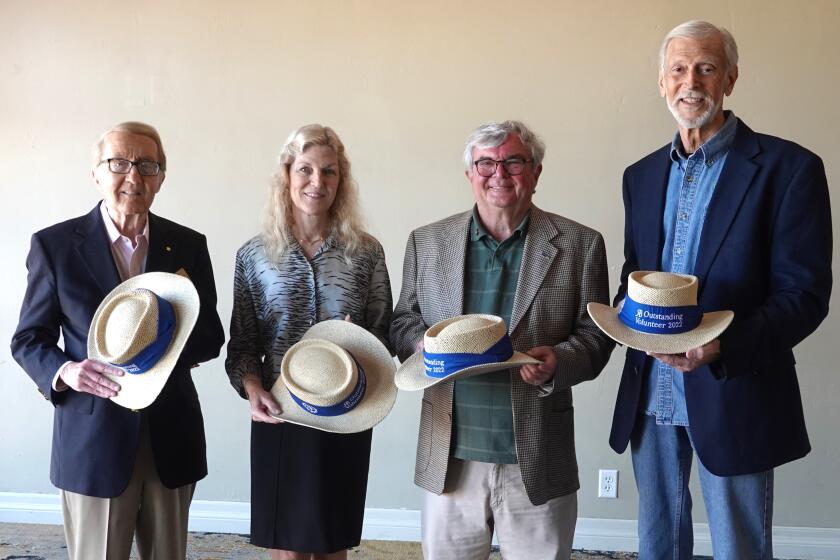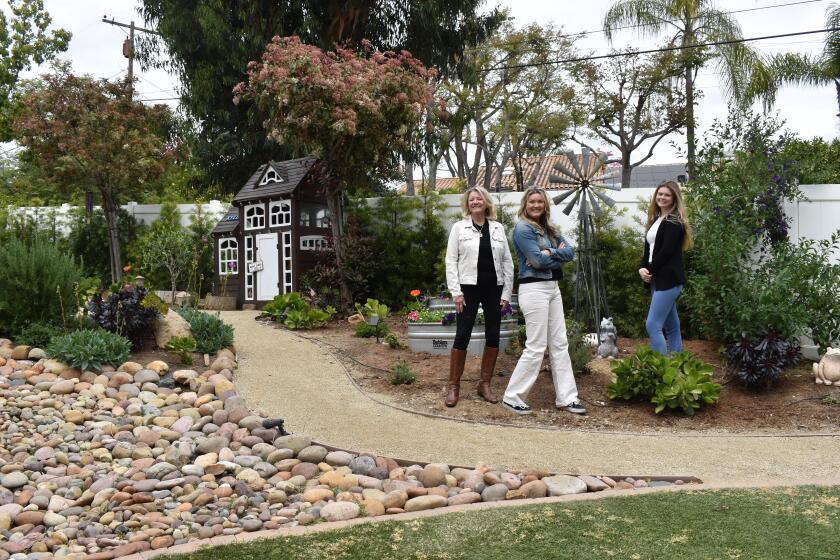Plants that can thrive despite drought
In response to the drought and imposed water restrictions, some locals might be considering replacing a portion or all of their water-thirsty lawns with drought-tolerant landscaping.
Tearing out all the grass and replacing it with a yard full of rocks is one option. Artificial turf is another. For those who want to go with one of these but enhance their property’s visual appeal with planting areas, or keep some of their real grass while downsizing its footage, there are attractive, natural options, according to local gardeners.
Planting beds full of succulents and cacti (a form of succulent) are popular around here. For those who do not want their yard to look like a desert, or worry frost might decimate their succulents — especially newly planted, not-yet-established ones — California natives and Mediterranean plants are a popular alternative for the Rancho Bernardo/4S Ranch/Poway area’s climate.
Sherry Rudrud, president of the Bernardo Gardeners Club, said she has dramatically renovated her Rancho Bernardo yard since moving here from Washington state five years ago. Coming from an area that received 90 inches or so of precipitation a year to Southern California’s single digits meant she had to learn about drought-tolerant and Mediterranean landscaping since she did not want succulents.
“You can have color without succulents and using a lot of water,” she said.
Rudrud has no grass. Her front and back yards are a mixture of plants among mulched areas, hardscape (patio and sidewalks) and small rock-filled paths. She irrigates once a week for about 10 minutes using micro drip sprayers that she installed herself, using her home’s existing spray-style sprinkler system as the basis but replacing or capping the spray heads.
For her California native plants, she gave them up to 30 gallons of water per session when first planted, but once they were established, almost never watered them again. The rare exception was this winter that was unseasonably warm and dry. Rudrud said they got a good soaking once a week.
“In nature they would not get (additional) water and I’m trying to replicate nature with my watering,” she said. “If it is very dry, I use a hose to moisten the soil around the plants.”
Her yard, which is a certified wildlife habitat due to providing the four basic habit elements needed for wildlife (food, water, cover and place to raise young), often attracts birds, butterflies and bees. She planted milkweed (where monarch butterflies love to lay their eggs) in the back of her planting beds because it can look unattractive later in the season when the butterfly eggs hatch since its leaves are the sole food source for the caterpillars, she said.
Rudrud said some of her favorite California native and Mediterranean plants due to their hardiness and looks are the many varieties of Arctostaphylos (aka manzanita “very easy and need no water once established”), Grevillea, Salvia, rosemary and Calylophus serrulatus. She also has a few dwarf fruit trees (including lemon and peach, which she keeps pruned short), blueberries and roses. All do well on once-a-week 10-minute watering sessions.
For guidance on how to create a drought-tolerant landscape, Rudrud said she turned to the staff at Las Pilitas Nursery in Escondido for advice since that is their speciality.
Poway Valley Garden Club members Roy Wilburn (co-president and horticulture manager at Sunshine Care in Poway), Dawn Standke (a Rancho Penasquitos resident and volunteer with the Master Gardener Association of San Diego County) and Emily Troxell (a Poway resident in the High Valley neighborhood), said planning is key to successfully transitioning a grass-filled lawn to a drought-tolerant landscape.
By creating a plan, people know exactly where their irrigation, hardscape, barbecue and lawn furniture, plants and other items will go before installing, even if done over an extended period of time, they said. This avoids problems down the line. Adding mulch is essential, not only to keep out weeds, but retain moisture.
Both Standke and Troxell (who has 2.5 acres) said they have no grass on their properties and said the “Nifty 50” list of is a good resource when selecting drought-tolerant plants that grow well in this area. It includes shrubs, succulents, vines, groundcover, ornamental grass, perennials and trees. Find it online at tinyurl.com/Nifty50List.
“A lot of native plants work well in Poway,” Troxell said. “As a group, they can have no water and come back after fire.”
She attributed her landscaping, a combination of California natives and succulents, for her house being mostly spared when fire surrounded it in 2007. Troxell said flames went under her plants near her home, but did not get engulfed since the plants did not ignite.
“Spend this summer planning on how to get rid of your lawn,” Standke advised. “Make sure it is dead. At the end of summer, put in the hardscape and in the fall and spring plant your plants so they will get established when it is not blazing hot and maybe we have rain.”
Standke said a yard can be very attractive and user-friendly if it mostly has hardscape, trees and planting beds. “You can have a fabulous backyard and use it more than ... a dying lawn.” She advises people to think about what they use — or want to use — their yard for, be it to entertain guests, have a place for pets or children to play. “If you have a modest-size backyard, maybe you need a bigger patio,” she said.
Wilburn said people need to identify their sunny and shady spots so they plant the correct plants in each. Also, determine their soil type since that influences plants’ success.
Standke said the easiest way to do this is to dig a 1 foot-by-1 foot-by-1 foot hole and fill it with water. If it disappears almost immediately, that is sandy soil that needs organic matter added since water will quickly drain away from plants and need more irrigation. If it takes up to 24 hours to soak in, the soil is “pretty good,” but could use compost. If after 24 to 48 hours there is still water then install raised beds, otherwise future plants are essentially going into a non-draining bowl.
“Clay soil gets a bad rap and people think they can’t grow anything in it,” Wilburn said, explaining with some amending plants can thrive.
Troxell said while people might want color, plants that just stay green year-round are also an attractive option they should consider, as are growing cycles since some go dormant for months at a time and look unattractive.
Standke advises people to contact the Master Gardener Association, a volunteer-based group that can give lots of free advice and can answer local’s questions. It can be reached at www.MasterGardenerSD.org or call the free hotline at 858-822-6910 between 9 a.m. and 3 p.m. on weekdays.





